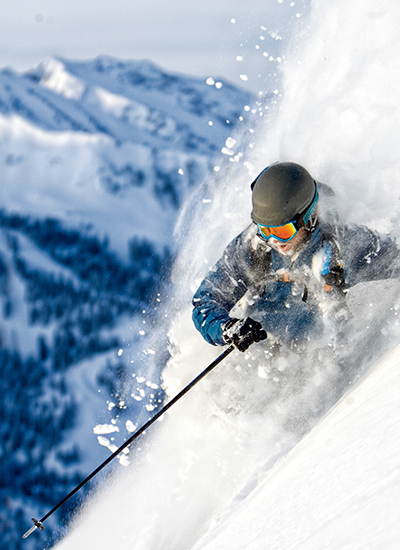Jeff Campbell’s Instagram feed is seeded with square shots of soldered circuit boards and technical diagrams charting pressure and friction. But any photo not shot in a University of Washington engineering lab is white and snowy—or of his steel-frame cyclocross bike on a gravel, Northwest back road. Campbell is a PhD candidate researching biomechanical engineering at UW Seattle, and he wouldn’t be where he is today without skiing—or a 2006 accident that shattered his left femur and knee.
Campbell, now 32, was a student at the University of Utah at the time, studying engineering, wrenching Caterpillar transmissions by night, skiing 100 days a season and scoring some top-15 finishes on the Freeskiing World Tour. The year before his accident, he’d landed Chad’s Gap, a 120-foot backcountry kicker between two piles of mine tailings in Alta’s Grizzly Gulch. (Tanner Hall famously broke both ankles on Chad’s that same year.)
One afternoon, while hot-lapping the tram at Snowbird, he sent a 40-footer in Lower Amphitheater, now called Femur Rock. “I tried to stomp the landing because I didn’t want to backseat it,” he says, “There was a bunch of rock that ended up snapping my femur and grenading my knee.”
In the ER, Jeff found himself talking with the surgeon about the hardwear he’d be getting in his leg—he was working in a lab testing such rods at the time. “I think I kind of caught him off guard,” Jeff says, “being just a ski bum.” But that accident solidified his interest in biomechanics, a subset of mechanical engineering that researches how orthopedic devices can improve and restore joint function. “My accident really brought in the focus of what I wanted my career path to be,” he says.
So he moved to Seattle in 2009 to begin a master’s degree in mechanical engineering, researching spinal implants for neck injuries. And between hut trips to British Columbia and ski missions in the Cascades, he began work with an advisor who regularly collaborates with an engineering firm to investigate terrain-park incidents. Campbell’s current research revolves around ski boot/binding interfaces, specifically the release properties of AT boots in alpine bindings. In May, he and his advisor, Dr. Irving Scher, presented their research before the International Organization for Standards (ISO) in Munich, Germany.
Scher notes that, as a skier, Campbell brings a lot to his field. “He’ll often come back from a day of skiing with a new idea about a test instrument to design or hypothesis to test,” Scher says. “When you’re as immersed in skiing as he is, you’re able to connect a lot of dots that others might miss.”
“You can see his engineering mind at work when he’s skiing as well,” ski partner and amateur photographer Joe Sullivan says. Campbell is notorious for staying up late on hut trips to analyze data, and friends say he brings scientific-level analysis to decision making. “The stuff he does for work really translates into snow safety,” adds Sullivan, an engineer himself, who appreciates the work-life ski balance he and his ski partner share.
Even though Campbell has landed cover shots and Chad’s Gap, he doesn’t consider himself a pro. “I’ve just been focused on engineering,” he says. “But the skintrack, or on a big hill climb on a bike, is where I get the best ideas…where I can clear my head and figure things out.”
This story first appeared in the September 2014 issue of Backcountry Magazine.











Related posts: